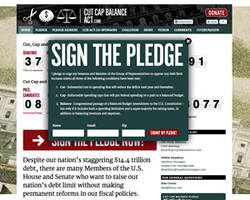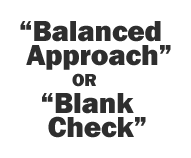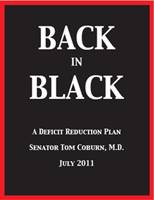Taming
the
National Debt
To the Wire on Default
The "Great" Debt Limit Debate of 2011
After Congress and the Administration successfully avoided a government shutdown in April 2011, Act Two quickly started. The debate revolved around the question of whether to raise the debt limit and, if so, what spending cuts Congress could and should extract as part of a deal (+). The Department of the Treasury and the Administration set out a position that "failing to increase the debt limit would have catastrophic economic consequences." According to Treasury, "Since 1960, Congress has acted 78 separate times to permanently raise, temporarily extend, or revise the definition of the debt limit." The debt ceiling stood at $14.294 trillion. On May 2, and reaffirmed on July 1, Treasury forecast that if Congress did not act to raise the limit, default would occur on August 2, 2011. (Ironically in 2006, then Senator Obama had voted against raising the debt ceiling, a fact which Republicans enjoyed pointing out). Tea Party activists pushed House Republicans to use the debt limit vote to force spending cuts (1, 2). Meetings at the White House yielded no progress and August 2 loomed ever closer. Despite the Administration's dire predictions, the debate headed to the wire.
A debate of this magnitude and intensity could not help but get caught up in presidential politics. Many of the presidential candidates signed on to the "cut, cap and balance pledge" advanced by conservatives. Some of the GOP presidential candidates were more vocal on the debt limit debate than others. Ron Paul ("Conviction") and Michele Bachmann ("Courage") even ran ads on the subject. By contrast Mitt Romney generally kept quiet on the matter.
Finally, on July 31, 2011 President Obama announced an agreement had been reached to raise the debt ceiling and avoid default. In addition to raising the debt limit so that the matter need not be considered again until 2013, the agreement calls for "10-year discretionary spending caps generating nearly $1 trillion in deficit reduction," and, perhaps most significantly, it creates a bipartisan committee which will identify $1.5 trillion in deficit reduction; Congress must vote on the committee's recommendations by December 23, 2011.
On August 1 the House voted to pass the agreement by 269-161 (Republicans 174-66 and Democrats 95-95). The next day the Senate passed it by a 74-26 vote and President Obama signed it into law.
Key Dates
May 5 - Vice President Joe Biden heads bipartisan talks starting with a meeting at Blair House.
May 9 - In a speech, Speaker John Boehner draws a line, stating, "Without significant spending cuts and reforms to reduce our debt, there will be no debt limit increase. And the cuts should be greater than the accompanying increase in debt authority the president is given
June 23 - The Biden talks reach an impasse, and the matter is kicked upstairs to the President.
July 13 - Moody's Investors Service announces it has "placed the Aaa bond rating of the government of the United States on review for possible downgrade given the rising possibility that the statutory debt limit will not be raised on a timely basis, leading to a default on US Treasury debt obligations" (+).
July 19 - House passes a "Cut, Cap and Balance" bill favored by conservatives, but seen as having no chance of advancing further.
At this point, "The Gang of Six" bipartisan group of Senators weighed in with "back to black" proposal which seemed to offer some promise.
July 22 - Negotiations between President Obama and Speaker Boehner on debt ceiling broke down. [letter, transcript]
July 25 - President Obama and Speaker Boehner delivered dueling speeches on debt ceiling. [Obama, Boehner, reactions]
July 29 - House passes the Budget Control Act of 2011, which included a balanced budget amendment. [statements and reactions]
July 31 - President Obama announces agreement had been reached to avoid default. [statement and reactions]
Aug. 1 - House votes to pass the agreement by 269-161 (Republicans 174-66 and Democrats 95-95).
Aug. 2 - Senate passed debt ceiling agreement by 74-26 and President Obama signs, averting default.
To the Wire on Default

The "Great" Debt Limit Debate of 2011
After Congress and the Administration successfully avoided a government shutdown in April 2011, Act Two quickly started. The debate revolved around the question of whether to raise the debt limit and, if so, what spending cuts Congress could and should extract as part of a deal (+). The Department of the Treasury and the Administration set out a position that "failing to increase the debt limit would have catastrophic economic consequences." According to Treasury, "Since 1960, Congress has acted 78 separate times to permanently raise, temporarily extend, or revise the definition of the debt limit." The debt ceiling stood at $14.294 trillion. On May 2, and reaffirmed on July 1, Treasury forecast that if Congress did not act to raise the limit, default would occur on August 2, 2011. (Ironically in 2006, then Senator Obama had voted against raising the debt ceiling, a fact which Republicans enjoyed pointing out). Tea Party activists pushed House Republicans to use the debt limit vote to force spending cuts (1, 2). Meetings at the White House yielded no progress and August 2 loomed ever closer. Despite the Administration's dire predictions, the debate headed to the wire.
A debate of this magnitude and intensity could not help but get caught up in presidential politics. Many of the presidential candidates signed on to the "cut, cap and balance pledge" advanced by conservatives. Some of the GOP presidential candidates were more vocal on the debt limit debate than others. Ron Paul ("Conviction") and Michele Bachmann ("Courage") even ran ads on the subject. By contrast Mitt Romney generally kept quiet on the matter.
Finally, on July 31, 2011 President Obama announced an agreement had been reached to raise the debt ceiling and avoid default. In addition to raising the debt limit so that the matter need not be considered again until 2013, the agreement calls for "10-year discretionary spending caps generating nearly $1 trillion in deficit reduction," and, perhaps most significantly, it creates a bipartisan committee which will identify $1.5 trillion in deficit reduction; Congress must vote on the committee's recommendations by December 23, 2011.
On August 1 the House voted to pass the agreement by 269-161 (Republicans 174-66 and Democrats 95-95). The next day the Senate passed it by a 74-26 vote and President Obama signed it into law.
Key Dates
May 5 - Vice President Joe Biden heads bipartisan talks starting with a meeting at Blair House.
May 9 - In a speech, Speaker John Boehner draws a line, stating, "Without significant spending cuts and reforms to reduce our debt, there will be no debt limit increase. And the cuts should be greater than the accompanying increase in debt authority the president is given
June 23 - The Biden talks reach an impasse, and the matter is kicked upstairs to the President.
July 13 - Moody's Investors Service announces it has "placed the Aaa bond rating of the government of the United States on review for possible downgrade given the rising possibility that the statutory debt limit will not be raised on a timely basis, leading to a default on US Treasury debt obligations" (+).
July 19 - House passes a "Cut, Cap and Balance" bill favored by conservatives, but seen as having no chance of advancing further.
At this point, "The Gang of Six" bipartisan group of Senators weighed in with "back to black" proposal which seemed to offer some promise.
July 22 - Negotiations between President Obama and Speaker Boehner on debt ceiling broke down. [letter, transcript]
July 25 - President Obama and Speaker Boehner delivered dueling speeches on debt ceiling. [Obama, Boehner, reactions]
July 29 - House passes the Budget Control Act of 2011, which included a balanced budget amendment. [statements and reactions]
July 31 - President Obama announces agreement had been reached to avoid default. [statement and reactions]
Aug. 1 - House votes to pass the agreement by 269-161 (Republicans 174-66 and Democrats 95-95).
Aug. 2 - Senate passed debt ceiling agreement by 74-26 and President Obama signs, averting default.


